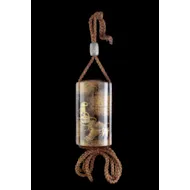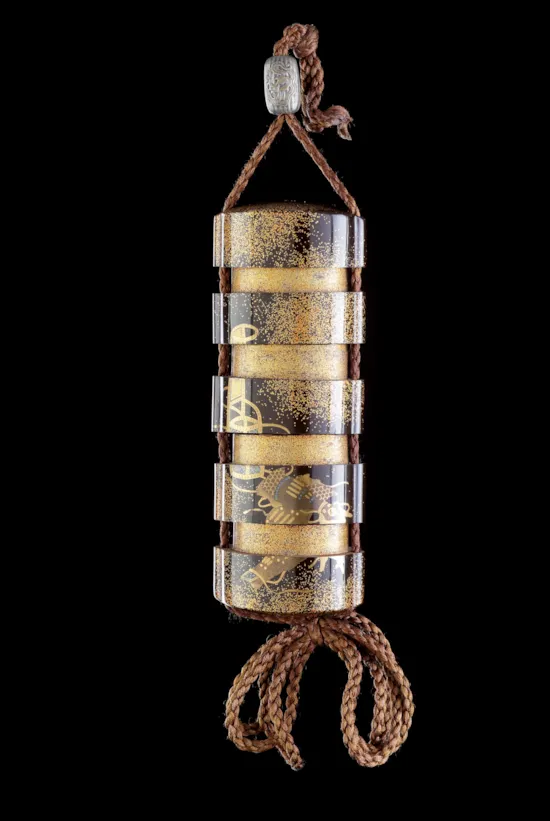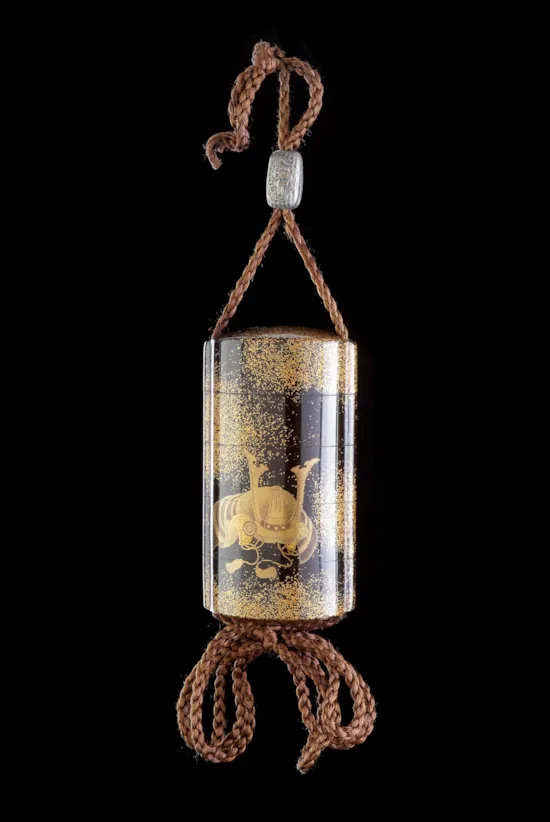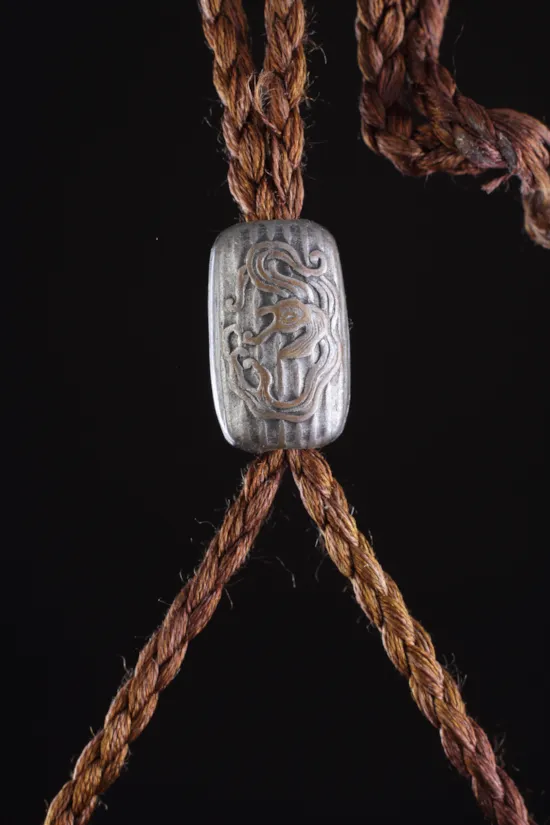Japanese Black Lacquered Four Case Inrō
A Fine Japanese Black Lacquered Four Case Inrō Decorated with a Samurai Helmet ‘Kabuto’ to one Side and a Court Cap ‘Eboshi’ Laying Together with a Pair of Samurai Armoured Gauntlets ‘Han Kote’ to the other the Roiro and Mura-Nashiji Ground Decorated with Gold and Silver Hiramaki-e with Details Inlaid in Aogai
With Silver Copper Ojime
Kanshōsai Toyo
Signed in raised gold lacquer: ‘Kanshōsai with Kao’
Late Edo Period Early 19th Century
Size: 8.5cm high, 4.5cm wide, 2.5cm deep - 3¼ ins high, 1¾ ins wide, 1 ins deep
With Silver Copper Ojime
Kanshōsai Toyo
Signed in raised gold lacquer: ‘Kanshōsai with Kao’
Late Edo Period Early 19th Century
Size: 8.5cm high, 4.5cm wide, 2.5cm deep - 3¼ ins high, 1¾ ins wide, 1 ins deep
A Fine Japanese Black Lacquered Four Case Inrō Decorated with a Samurai Helmet ‘Kabuto’ to one Side and a Court Cap ‘Eboshi’ Laying Together with a Pair of Samurai Armoured Gauntlets ‘Han Kote’ to the other the Roiro and Mura-Nashiji Ground Decorated with Gold and Silver Hiramaki-e with Details Inlaid in Aogai
With Silver Copper Ojime
Kanshōsai Toyo
Signed in raised gold lacquer: ‘Kanshōsai with Kao’
Late Edo Period Early 19th Century
Size: 8.5cm high, 4.5cm wide, 2.5cm deep - 3¼ ins high, 1¾ ins wide, 1 ins deep
With Silver Copper Ojime
Kanshōsai Toyo
Signed in raised gold lacquer: ‘Kanshōsai with Kao’
Late Edo Period Early 19th Century
Size: 8.5cm high, 4.5cm wide, 2.5cm deep - 3¼ ins high, 1¾ ins wide, 1 ins deep
The original functioning of the inrō was as a box for holding a seal which was later divided into two in order to carry the ink wadding as well. First developed in the 16th century, by the 17th century they had more compartments and often carried an assortment of medications like a small ‘Yakuro’ or medicine chest.
The most characteristic of Japanese lacquering techniques was ‘maki-e’ which literally means ‘sprinkled picture’ and the essence of maki-e is that the design is sprinkled in metal dust, usually gold or silver from a bamboo tube onto a coat of still wet lacquer which has been painted over a previously applied and dried lacquer ground. The artist Toyo lizuka who frequently used the name Kanshōsai was a lacquer master who working from 1764 to 1772 specialised in togidashi, especially sumi-e-togidashi. This technique was used by lacquer artists to simulate the effect of Ukiyo-e prints as they sought to exploit the immense popularity of woodblock prints during the 18th and 19th centuries.
Toyo lizuka was succeeded by several related generations of artists who made inrō and who adopted his name.
The most characteristic of Japanese lacquering techniques was ‘maki-e’ which literally means ‘sprinkled picture’ and the essence of maki-e is that the design is sprinkled in metal dust, usually gold or silver from a bamboo tube onto a coat of still wet lacquer which has been painted over a previously applied and dried lacquer ground. The artist Toyo lizuka who frequently used the name Kanshōsai was a lacquer master who working from 1764 to 1772 specialised in togidashi, especially sumi-e-togidashi. This technique was used by lacquer artists to simulate the effect of Ukiyo-e prints as they sought to exploit the immense popularity of woodblock prints during the 18th and 19th centuries.
Toyo lizuka was succeeded by several related generations of artists who made inrō and who adopted his name.
Ex Edward A. Wrangham (1928 - 2009) collection
Ex Private London collection
Acquired from Rosemary Bandini Ltd
Ex Private London collection
Acquired from Rosemary Bandini Ltd
Japanese Black Lacquered Four Case Inrō














